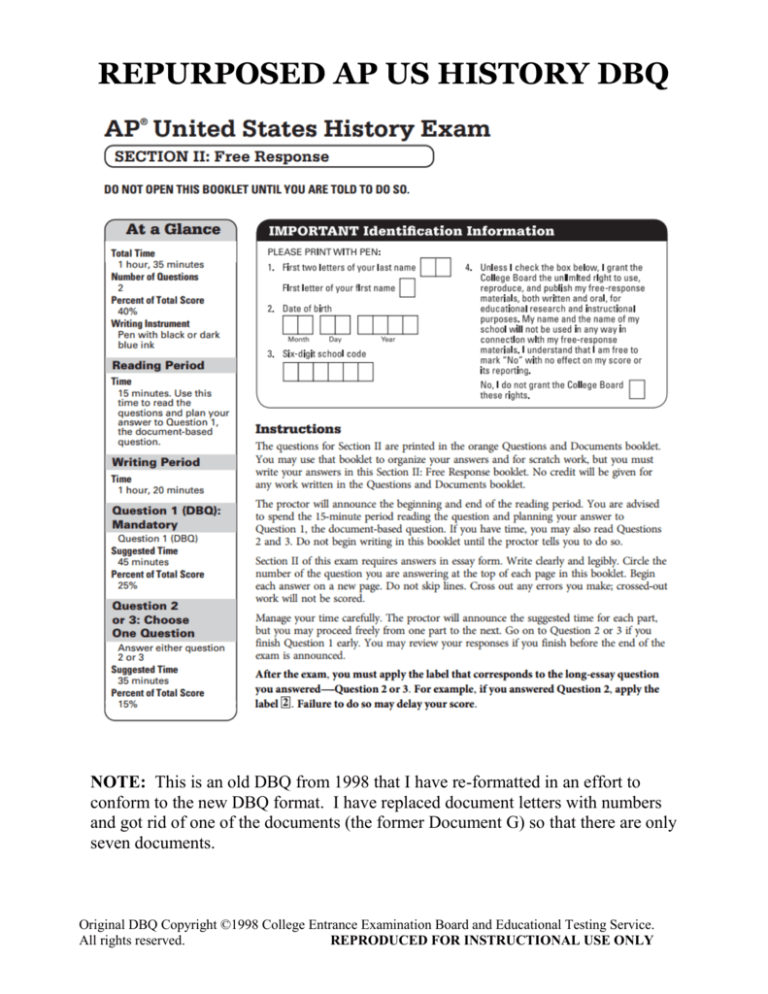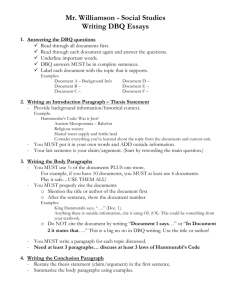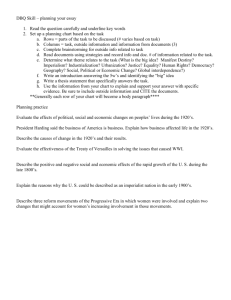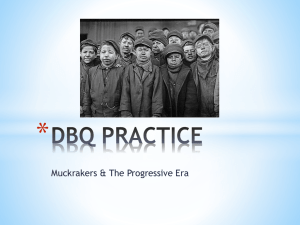
REPURPOSED AP US HISTORY DBQ
NOTE: This is an old DBQ from 1998 that I have re-formatted in an effort to
conform to the new DBQ format. I have replaced document letters with numbers
and got rid of one of the documents (the former Document G) so that there are only
seven documents.
Original DBQ Copyright ©1998 College Entrance Examination Board and Educational Testing Service.
All rights reserved.
REPRODUCED FOR INSTRUCTIONAL USE ONLY
UNITED STATES HISTORY
SECTION II
Total Time – 1 hour, 30 minutes
Question 1 (Document-Based Question)
Suggested Reading period: 15 minutes
Suggested writing time: 40 minutes
Directions: The following question is based on the accompanying Documents 1–7. The documents have
been edited for the purpose of this exercise. This question is designed to test your ability to apply several
historical thinking skills simultaneously, including historical argumentation, use of relevant historical
evidence, contextualization, and synthesis. Your response should be based on your analysis of the
documents and your knowledge of the topic.
Write a well-integrated essay that does the following:
States an appropriate thesis that directly addresses all parts of the question
Supports the thesis or an appropriate argument with evidence from all or all but one of the
documents AND your knowledge of European history beyond/outside the documents
Analyzes a majority of the documents in terms of such features as their intended audience,
purpose, point of view, format, argument, limitations, and/or social context as appropriate to
the argument
Places the argument in the context of broader regional, national, or global processes
1. With respect to the federal Constitution, the Jeffersonian Republicans are usually
characterized as strict constructionists who were opposed to the broad constructionism of the
Federalists. To what extent was this characterization of the two parties accurate during the
presidencies of Jefferson and Madison?
In writing your answer, use the documents and your knowledge of the period 1801-1817.
Original DBQ Copyright ©1998 College Entrance Examination Board and Educational Testing Service.
All rights reserved.
REPRODUCED FOR INSTRUCTIONAL USE ONLY
Document 1
Source: Thomas Jefferson to Gideon Granger, a future member of Jefferson's cabinet, 13
August 1800.
I believe [we] shall obtain. . .a majority in the legislature of the United States, attached to the
preservation of the federal Constitution, according to its obvious principles and those on
which it was known to be received; attached equally to the preservation to the states of those
rights unquestionably remaining with them; . . .in short, a majority firm in all those
principles which we have espoused, and the Federalists have opposed uniformly. . . . It [our
country] can never be harmonious and solid while so respectable a portion of its citizens
support principles which go directly to a change of the federal Constitution, to sink the state
governments, consolidate them into one, and to monarchise that.
Our country is too large to have all its affairs directed by a single government. . . .
The true theory of our Constitution is surely the wisest and best that the states are
independent as to everything within themselves, and united as to everything respecting
foreign nations.
Document 2
Source: Jefferson to Samuel Miller, a Presbyterian minister, 23 January 1808.
I consider the government of the United States as interdicted by the Constitution from
intermeddling with religious institutions, their doctrines, discipline, or exercises. . . .
Certainly no power to prescribe any religious exercise, or to assume authority in religious
discipline, has been delegated to the general [federal] government. It must then rest with the
states, as far as it can be in any human authority. . . .
I am aware that the practice of my predecessors [prescribing a day of fasting and prayer]
may be quoted. . . . Be this as it may, everyone must act according to the dictates of his own
reason, and mine tells me that civil powers alone have been given to the President of the
U.S. and no authority to direct the religious exercises of his constituents.
Original DBQ Copyright ©1998 College Entrance Examination Board and Educational Testing Service.
All rights reserved.
REPRODUCED FOR INSTRUCTIONAL USE ONLY
Document 3
Source: Alexander Anderson cartoon, 1808.
© Collection of The New-York Historical Society
Original DBQ Copyright ©1998 College Entrance Examination Board and Educational Testing Service.
All rights reserved.
REPRODUCED FOR INSTRUCTIONAL USE ONLY
Document 4
Source: Daniel Webster, Federalist from New Hampshire, in a speech on a conscription bill,
to the House of Representatives, 9 December 1814.
The [Madison] administration asserts the right to fill the ranks of the regular army by
compulsion. . . . Where is it written in the Constitution, in what article or section is it
contained, that you may take children from their parents, and parents from their children, and
compel them to fight the battles of any war in which the folly or the wickedness of the
government may engage it? . . . Who will show me any constitutional injunction which makes
it the duty of the American people to surrender everything valuable in life, and even life
itself, . . . whenever the purposes of an ambitious and mischievous government may require
it?. . .
If the secretary of war has proved the right of Congress to enact a law enforcing a draft of
men out of the militia into the regular army, he will at any time be able to prove quite as
clearly that Congress has power to create a dictator.
Document 5
Source: Report and Resolutions of the Hartford Convention, 4 January 1815.
Resolved, That the following amendments of the constitution of the United States be
recommended to the states represented as foresaid, to be proposed by them for adoption by
the state legislatures, and in such cases as may be deemed expedient by a convention chosen
by the people of each state. . . .
Second. No new state shall be admitted into the Union by Congress, in virtue of the power
granted by the constitution, without the concurrence of two thirds of both houses.
Third. Congress shall not have the power to lay any embargo on the ships or vessels of the
citizens of the United States, . . . for more than sixty days.
Fourth. Congress shall not have power, without concurrence of two thirds of both houses, to
interdict the commercial intercourse between the United States and any foreign nation, or the
dependencies thereof.
Original DBQ Copyright ©1998 College Entrance Examination Board and Educational Testing Service.
All rights reserved.
REPRODUCED FOR INSTRUCTIONAL USE ONLY
Document 6
Source: John Randolph, a Democratic Republican congressman from Virginia, in a speech to
the House on the proposed tariff of 1816.
[W]e have another proof that the present government have renounced the true republican
principles of Jefferson's administration on which they raised themselves to power, and that
they have taken up, in their stead, those of John Adams . . . . [T]heir principle now is old
Federalism, vamped up into something bearing the superficial appearance of republicanism . .
. . Sir, I am convinced that it would be impolitic, as well as unjust, to aggravate the burdens
of the people for the purpose of favoring the manufacturers; for this government created and
gave power to Congress to regulate commerce and equalize duties [tariffs] on the whole of
the United States, and not to lay a duty [tariff] but with a steady eye to revenue . . . .
Document 7
Source: James Madison: Message to Congress vetoing an Internal Improvements Bill, March,
1817.
[I have] considered the bill this day presented to me entitled 'An act to set apart and pledge
certain funds for internal improvements,' and which sets apart and pledges funds. . . for
constructing roads and canals, and improving the navigation of water courses. . . . The power
to regulate commerce among the several states cannot include a power to construct roads and
canals. . . . I am not unaware of the great importance of roads and canals and the improved
navigation of water courses, and that a power in the national legislature to provide for them
might be exercised with signal advantage to the general prosperity. But seeing that such a
power is not expressly given by the Consti-tution, and believing that it can not be deduced
from any part of it without an inadmissible latitude of construction and a reliance on
insufficient precedents; believing also that the permanent success of the Constitution depends
on a definite partition of powers between the general [federal] and the state governments. . . I
have no option but to withhold my signature from it . . .
Original DBQ Copyright ©1998 College Entrance Examination Board and Educational Testing Service.
All rights reserved.
REPRODUCED FOR INSTRUCTIONAL USE ONLY
APUSH DBQ RUBRIC
Name: ____________________
Updated August 2015
THESIS & ARGUMENT
DBQ: _____________________
(TWO POINTS)
POINT?
1. THESIS PRESENT
Presents a thesis that makes a historically defensible claim
and responds to all parts of the question (does more than re-state).
Must be located in the introduction or conclusion (first or last paragraph).
2. THESIS EXCELLENT / THESIS-DRIVEN
Develops and supports a cohesive
argument that recognizes and accounts for historical complexity by explicitly
illustrating relationships among historical evidence such as contradiction,
corroboration, and/or qualification.
DOCUMENT ANALYSIS
Used
(TWO POINTS)
POV / CAP (Any)
3. USES the content of
at least SIX of the
documents to support the
stated thesis or a relevant
argument
Context, Audience, Purpose
D__
D__
D__
D__
4. EXPLAINS the significance
of author’s POV, context,
audience, and/or purpose
(CAP) for at least FOUR
documents.
D__
D__
EVIDENCE & CONTEXT
(TWO POINTS)
5. CONTEXTUALIZATION
Situates the argument by explaining the broader
historical events, developments, or processes immediately relevant to the
question. NOTE: This must be more than a phrase or reference – use multiple sentences.
6. EVIDENCE BEYOND THE DOCUMENTS Provides an example or additional piece
of specific evidence beyond those found in the documents to support or qualify
the argument. Must be 1) distinct from evidence used to earn other points and 2) more than a
mere phrase or reference.
SYNTHESIS
(ONE POINT)
7. Extends the argument by explaining the connections between the argument and:
A development in a different historical period, situation, era, or geographical area
OR A course theme and/or approach to history that is not the focus of the essay (political, social, etc.)
NOTES:
TOTAL POINTS:
/7
For more information about the APUSH DBQ, visit my website: http://www.tomrichey.net





